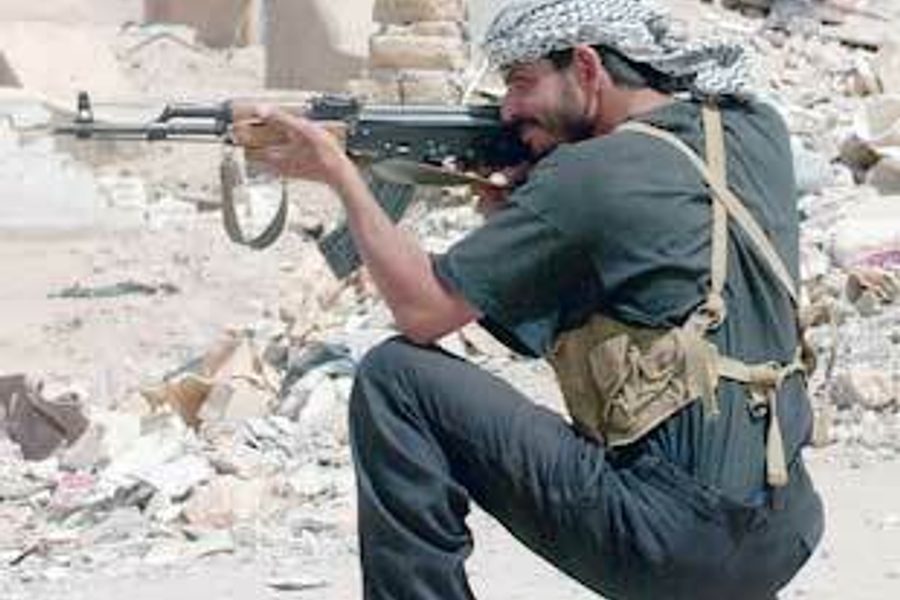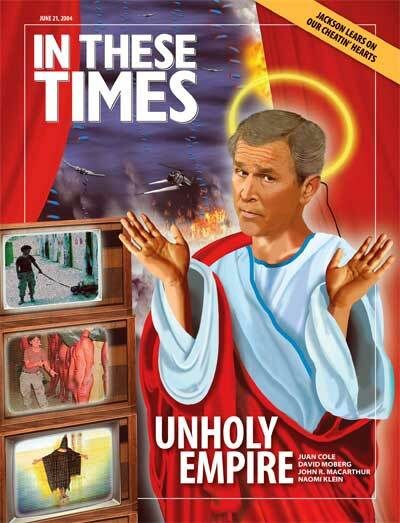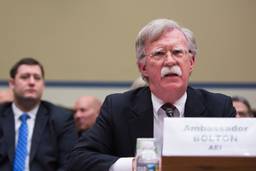The Great Uprising of early April 2004 boiled along into May, leaving Iraq in continued turmoil. The Bush administration unwisely provoked rebellions in both Fallujah and Najaf (and other southern Shiite towns) by deciding to put down small symbolic acts of defiance with massive force. In Fallujah, Geroge W. Bush ordered the American military to retreat from that Sunni Arab city and to rehabilitate the Baathist forces once associated with Saddam Hussein to help restore order. Yet in Najaf, Bush has been unyielding in his determination to arrest or kill the young radical Shiite cleric Muqtada al-Sadr and destroy his militia. That determination could tip the Shiite south into long-term instability.
Given the drumbeat of bombings and assassinations, most recently of Izzedine Salim, president of the interim government of Iraq, the country cannot take much more instability. The transfer of sovereignty scheduled for June 30 is not in doubt, since it simply requires some appointments and paperwork. But endowing the new government with any popular support and political reality will be difficult if the country is in flames. By mid-May, the Najaf home of the preeminent mainstream Shiite leader, Grand Ayatollah Ali Sistani, was being sprayed by machine gun fire from unknown assailants. This raises the specter of his loss to assassination, as well, which could further radicalize the Shiites.
Al-Sadr, 30, inherited a large and active Shiite dissident movement from his father, who, under the nose of Saddam Hussein, had established it in the Shiite slums of the southern cities. The Baath Party found it difficult to penetrate and control the teeming ghetto of East Baghdad, allowing the Sadrist organization to flourish there. In 1999, Saddam had Ayatollah Muhammad Sadiq al-Sadr, Muqtada’s father, killed along with Muqtada’s two older brothers. Muqtada Al-Sadr went underground and emerged over the next four years as a new, sectarian leader of Iraq’s dispossessed, guided by an ideology that differed little from that of Iran’s Ayatollah Khomeini, his father’s teacher.
The army of the Mahdi rises
When the United States overthrew Saddam, the Sadrists were free to establish soup kitchens and offer social services, to provide security through neighborhood militias and to organize huge Friday prayer services attended by thousands. They demanded through repeated small demonstrations that the Americans leave immediately. On July 18, 2003, al-Sadr announced the formation of his militia, the army of the Mahdi. Its name suggests that he sees the coming of the Muslim promised one, the Mahdi, as imminent.
Al-Sadr’s attempt in fall of 2003 to persuade his followers to support the formation of a shadow government to challenge the Coalition Provisional Authority fizzled. After two local clashes between U.S. troops and his supporters, al-Sadr was threatened with arrest, and he fell silent for months. In March, however, he again began to denounce continued U.S. presence in Iraq. When the Israeli government of Arial Sharon assassinated Hamas leader Sheikh Ahmed Yassin in Gaza, Muqtada’s newspaper, al-Hawzah, gave the incident front-page play. Al-Sadar himself pledged to be the “right arm” of Hamas in Iraq, and the Americans became alarmed that the radical Shiite might align himself with radical Palestinians.
This prospect of a new Islamist international probably impelled the Americans to issue arrest warrants for 28 of al-Sadr’s close aides on April 3, and to arrest 13 of them. Al-Sadr’s militia had not been violent toward Americans, and the Bush administration’s decision to go after him appears to have been a matter of policy. Al-Sadr, having lived under the Baath, knew that his own arrest was in the offing, and he launched a preemptive rebellion to underscore the fact that he would not go quietly. At his command, the Shiite south was shaken by an uprising led by the Mahdi army. Kut, Amara, Nasiriyah, East Baghdad, Karbala, Kufa and Najaf all saw fierce fighting with Coalition troops. Gen. Rick Sanchez announced that the U.S. military intended to “capture or kill” al-Sadr.
The radical cleric cleverly moved from his home base of Kufa to the shrine of Ali in nearby Najaf. The tomb of Ali, the cousin and son-in-law of the Prophet Muhammad, is venerated by both Shiites and Sunnis, and its sanctity made it difficult for the U.S. Army to simply invade and grab Muqtada. Under severe pressure from its Shiite allies on the Interim Governing Council, the United States abandoned its plans for an immediate push on downtown Najaf and agreed to allow Shiite forces to attempt to negotiate with the radical cleric.
In other cities the United States continued to wage a war of attrition against the Mahdi army. However, American troops were unable to decisively crush the Sadrists, who could simply go home and store their weapons if they felt in too much danger and then come back out when the pressure lessened. The combination of standoff in Najaf and fierce continued fighting in Karbala, East Baghdad, Nasiriyah and some other cities plunged the south of the Iraq into turmoil previously seen only in the Sunni Arab heartland.
Sadrists hunker down
Spokesmen for the Coalition Provisional Authority and the U.S. military like to imply that al-Sadr is a minor figure with a miniscule following that has made itself significant only because of its thuggish tactics. A poll taken in late March and reported in the Washington Post, however, showed that a large proportion of Iraqis from central and southern Iraq backed Muqtada. Fully 67 percent of the population of Basra said they stood behind him, and 45 percent of those in Baghdad did. Since Baghdad is about 40 percent Shiite, that poll result suggests he is overwhelmingly popular among Shiites there and has attracted the admiration of a minority of Sunnis, as well. The poll was taken before the dramatic Sadrist uprising of early April, and it is likely that popular support for him has increased since.
The United States has two possible strategies for dealing by force with the scrappy al-Sadr, ensconced in the shrines of Najaf. It could send the Army into Najaf, risking the rage of pious Shiites about the consequent desecration of their holy city. Or it could use a proxy militia of Iraqis to accomplish that goal. According to my sources, some Shiite members of the Interim Governing Council favored employing tribal levies — armed young men from the Shiite clans around Najaf — to invade the holy city and capture Muqtada but were overruled by chief administrator Paul Bremer.
Of course, there is a proved model for a negotiated settlement, the Fallujah option. The United States could draw the army of the Mahdi into a new Shiite security force and work out some deal that would allow al-Sadr to save face while neutralizing him politically (e.g. having the grand ayatollahs issue a fatwa putting him under house arrest until the new Iraqi government could put him on trial after June 30). Such a plan was endorsed by some powerful figures in the U.S. military, including Gen. Martin Dempsey, but in the end Bush and Secretary of Defense Donald Rumsfeld appear to have insisted that U.S. troops wage a war of attrition on the army of the Mahdi.
Despite severe military pressure on his supporters in several southern cities, al-Sadr continued to denounce the Americans and his internal Iraqi enemies. In his Friday sermon of April 30, he condemned the United States for the deal it had made with ex-Baathists in resolving the Fallujah standoff. He said that the Americans “are attempting to return the Baathists to the administration of the state. I will not permit it. They will meet their end at the hands of the believers.” He also lashed out at the Interim Governing Council, asserting that it was humiliating itself by not responding decisively to this development. He wondered why the Shiite al-Dawa Party, which had sought to overthrow Saddam and had been especially targeted for reprisals, was silent.
Al-Sadr singled out for ridicule his rival Abdul Aziz al-Hakim, the Shiite cleric whom for two decades headed a guerrilla group, the Badr Corps, the paramilitary arm of the Supreme Council for Islamic Revolution in Iraq, then based in Iran. Taunting al-Hakim, al-Sadr said: “Where is the Supreme Council for Islamic Revolution in Iraq, which claims to combat the Baathists and where is the al-Da‘wa Party, with whose members the Baathists once filled their prisons?”
Some Shiites, who still hoped a means could be found to resolve the crisis, suggested that he tone down his denunciations of the United States. Others feared the United States might give Najaf the Fallujah treatment, massively bombarding it. Muqtada rejected these entreaties, saying, “I have recently been requested to moderate my tone, since it risks drawing the wrath of the enemy down on us, but I shall never be silent.”
United States loses face
The scandal over the American torture and abuse of Iraqi prisoners at Abu Ghraib, undercut the moral standing of the United States in Iraq and played into al-Sadr’s hands. In his May 7 sermon at Kufa, he asked, “What sort of freedom and democracy can we expect from you [Americans] when you take such joy in torturing Iraqi prisoners?” He demanded that the U.S. guards accused of abuse be tried by Iraqi courts. And he dismissed President Bush’s expressions of regret: “Your statements are not enough. They [the guards] must be punished in kind.” The American vow to make al-Sadr himself a prisoner looked much more sinister in the wake of the Abu Ghraib revelations.
Grand Ayatollah Sistani, the preeminent formal religious authority in Iraq, remained quieter than most Shiites would have liked. He issued a strong denunciation of al-Sadr for his threat to unleash suicide bombers against the Americans if they invaded Najaf. Until May 18, however, Sistani remained silent as the United States came in to crush the Sadrists in the holy cities of Najaf and Karbala. Initially, Sistani appeared to have calculated that the Sadrists formed a long-term threat to his religious authority (al-Sadr’s followers once tried to expel the grand ayatollah from Najaf), and that he had no choice but to allow the United States to crush them. He then called on Shiites to demonstrate throughout the country against the desecration of the holy city of Najaf caused by open warfare between the United States and the Mahdi army (implicitly condemning both and calling for U.S. withdrawal).
Intensive mediation efforts had been mounted between Paul Bremer, representing Bush, and Muqtada al-Sadr. One by one a parade of mediators showed up in Najaf. The reformist president Mohammad Khatami of Iran sent a delegation, but the assassination of an Iranian embassy official convinced the Iranians that it was unwise to get involved and they withdrew. The al-Da‘wa Party, led by the elegant if inarticulate Ibrahim Jaafari, made its try. Even the Supreme Council for Islamic Revolution in Iraq, despite its abhorrence of Muqtada, took a turn. The Najaf police chief got involved. Tribal chieftains came and went. The new head of Iraqi internal security also gave it a go.
Mediation falls flat
Why did these intensive negotiations, lasting well more than a month, fail? Former Interim Governing Council member Abdul Karim al-Muhammadawi, who had suspended his membership to protest what he saw as heavy-handed U.S. tactics at Fallujah, blamed Bremer for insisting that the only acceptable outcome of any negotiation would be for al-Sadr to surrender himself to the Americans. Al-Sadr’s family history advised against self-surrender. His father-in-law and distant cousin, Muhammad Baqir al-Sadr, had been a prominent theorist of Islamic Revolution for the al-Da‘wa Party. Saddam had him hanged in 1980. His father and two older brothers were machine-gunned to death in 1999 by Saddam’s secret police. The al-Sadrs do not go quietly.
In essence, al-Muhammadawi charged, the United States was not interested in actual negotiation and compromise, only in capitulation. Al-Muhammadawi, the “Prince of the Marshes,” had led the Iraqi Marsh Arabs under the rubric of Iraqi Hezbollah, in attacks on Saddam’s forces. His Marsh Arab gunmen in Amara and Kut now seem increasingly likely to throw in their lot with the Mahdi army against the Italians and British, having been radicalized by the long foreign occupation.
The struggle between the Americans and al-Sadr, far from remaining a Shiite issue, has taken on national significance. Both the more radical Sunni Muslims and the Kurds weighed in. Predictably, they disagreed with one another.
Among the more important Sunni religious groups is the Board of Muslim Clergy. It played a significant mediating role between the Americans and the populace of Fallujah in April, but some of its members have been accused of having their own ties to radicals. The Board of Muslim Clergy is headed by Sheikh Harith al-Dhari.
In early May, al-Dhari condemned U.S. threats to kill or capture al-Sadr. He alleged that this anti-al-Sadr policy was a calculated ploy by the United States to help enable a U.S. military attack on Fallujah. The United States saw Muqtada as an impediment, al-Dhari said, because he is a nationalist, unlike most of the other Shiite leaders who have been willing to cooperate with the United States. “Here I say that were they to implement their threat to kill or capture Muqtada al-Sadr, that would add yet another act of stupidity to all the other acts of stupidity that the Occupation forces have committed. For Muqtada al-Sadr has many followers in Shiite circles, and therefore any attempt to assassinate him might lead to unhappy consequences.” On May 8, al-Dhari and 500 like-minded Iraqi nationalists met in Baghdad and expressed their support for al-Sadr.
Likewise, the people of Sunni Arab Fallujah showed their support for al-Sadr by sending nine trucks full of food and medicine to Kufa, al-Sadr’s urban base. They were returning a favor. The Sadrists had helped send a convoy of supplies to Fallujah when it was being besieged in early April.
Factions recrystallize
Fallujah’s pan-Arabism and pan-Islamism does not appeal everywhere. The northern Kurdish minority in Iraq is not Arab but speaks an Indo-European language, and its religious tendencies are seldom fundamentalist. A leading Kurdish newspaper of the Kurdistan Democratic Party, based in the northern city of Irbil, published an attack on al-Sadr on May 11. The author warned that if the Sadrists were not repressed they would ignite an inferno in Iraq and throughout the Persian Gulf. He contrasted al-Sadr to his Shiite rivals, who reject Khomeini’s theory of clerical rule. In “the framework of a democratic state,” he said, al-Sadr was an impediment to mutual understanding between Kurds and Arabs, Shiites and Sunnis. Why the difference between the views of the Sunni Arab Board of Muslim Clergy and the Kurds?
Al-Sadr has repeatedly called for a strong central government in Iraq and has denounced Kurdish plans for semi-autonomy. He also condemned Kurdish designs on the oil city of Kirkuk, and sent 2,000 fighters there to support the Arabs and Turkmen. Many Turkmen are Shiites and apparently a significant number follow al-Sadr. For the more radical Sunni Arabs, national independence from the Americans is more important than any other value, and they see Muqtada as a key ally against American imperialism. The Kurdish regions are not occupied militarily by the United States, and Kurds have long viewed the Americans as an ally against the Baathists in Baghdad. For Kurds, al-Sadr represents a sectarian form of Arab nationalism just as dangerous to them as the Baath had been.
The U.S. campaign against al-Sadr has crystallized key fissures in Iraqi society. It demonstrates the severe divisions among the Shiites, which have allowed the United States to move into Najaf and Karbala. Had those cities put up a unified resistance, as Sunni Fallujah did, the Americans would have had to back off. Instead, they could count on help from Shiite allies who despise al-Sadr and his followers. The United Sates also had the backing of the Kurds, some of whom fought the Mahdi army on behalf of the Americans, because they feared al-Sadr would attempt to impose Shiite clerical rule on them.
Despite widespread public support, al-Sadr’s movement picked up only two effective allies. One was the Shiite Marsh Arabs who, displaced when Saddam drained their swamps in the south, had moved to urban slums where Muqtada was popular. The other was the Sunni fundamentalists of a nationalist mindset, who admired him as an anti-imperialist politician.
In pursuing al-Sadr and the army of the Mahdi, the U.S. military has fought in close proximity to the most sacred shrines of Shiite Islam, desecrating holy cemeteries and destroying at least one historic mosque. This desecration, coming on top of the siege of Fallujah and the revelations of prison torture, has made the United States increasingly unpopular in the Shiite south, which before March had been relatively quiet. Whatever victory the United States finally achieves against al-Sadr will almost certainly be a Pyrrhic one. At best, the Americans and their allies will face an ongoing low-grade Shiite insurgency. At worst, they will be hated by a majority of the Shiites in the south and demands for an immediate U.S. withdrawal will proliferate.








